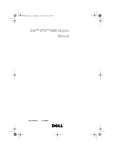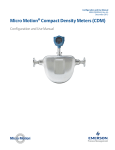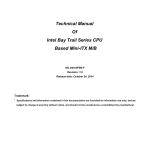Download Dell XPS 8500 XPS 8500 User's Manual
Transcript
book.book Page 1 Wednesday, October 10, 2012 10:32 PM Dell™ XPS™ 8500 Owner’s Manual Regulatory model: D03M Regulatory type: D03M005 w w w. d e l l . c o m | s u p p o r t . d e l l . c o m / m a n u a l s book.book Page 2 Wednesday, October 10, 2012 10:32 PM Notes, Cautions, and Warnings NOTE: A NOTE indicates important information that helps you make better use of your product. CAUTION: A CAUTION indicates either potential damage to hardware or loss of data, and tells you how to avoid the problem. WARNING: A WARNING indicates a potential for property damage, personal injury, or death. ____________________ © 2012 Dell Inc. All rights reserved. Trademarks used in this text: Dell™, the DELL logo, and XPS™ are trademarks of Dell Inc. Microsoft®, Windows®, and the Windows start button logo are either trademarks or registered trademarks of Microsoft Corporation in the United States and/or other countries. Bluetooth® is a registered trademark owned by Bluetooth SIG, Inc. and is used by Dell under license. 2012 - 10 Rev. A01 book.book Page 3 Wednesday, October 10, 2012 10:32 PM Contents 1 Before You Begin . . . . . . . . . . . . . . . . . . . Turn Off Your Computer and Connected Devices Safety Instructions . . . . . 13 . . . . . . . . . . . . . . . . . . . 13 Recommended Tools . . . . . . . . . . . . . . . . . . . 2 After Working Inside Your Computer . 3 Technical Overview . 15 . . . . . . . . . . . . . . . . 17 Front View of Your Computer . . . . . . . . . . . . . . 18 Back View of Your Computer . . . . . . . . . . . . . . 19 . . . . . . . . . . . . . 20 . . . . . . . . . . . . . . . 21 . . . . . . . . . . . . . . . . . . . 23 System-Board Components 5 14 . . . Inside View of Your Computer . 4 13 Computer Cover . Removing the Computer Cover . . . . . . . . . . . . . 23 Replacing the Computer Cover . . . . . . . . . . . . . 25 . . . . . . . . . . . . . . . . . 27 . . . . . . . . . . . . . . . . . . . . . . 27 Memory Module(s) Prerequisites . Contents 3 book.book Page 4 Wednesday, October 10, 2012 10:32 PM Removing Memory Module(s) . . . . . . . . . . . . . . . . . . . . . . . . . . . 28 . . . . . . . . . . . . . . . . . . . . . . 30 Replacing Memory Module(s) . Postrequisites 6 Front Bezel . . . . . . . . . . . . . . . . . . . . . . . Prerequisites . 31 Replacing the Front Bezel . . . . . . . . . . . . . . . . 33 . . . . . . . . . . . . . . . . . . . . . . 34 Graphics-Card Bracket (optional) . . . . . . . . . . . . . . . . . . . . . . . 35 35 . . . . . . . . . 35 Replacing the Graphics-Card Bracket. . . . . . . . . . 36 . . . . . . . . . . . . . . . . . . . . . . 36 Graphics Card Prerequisites . . . . . . . . . . . . . . . . . . . . . . . . . . . . . . . . . . . . . . . . . . . 37 37 Removing the Graphics Card. . . . . . . . . . . . . . . 37 Replacing the Graphics Card . . . . . . . . . . . . . . 39 . . . . . . . . . . . . . . . . . . . . . . 41 Postrequisites Contents . . . . Removing the Graphics-Card Bracket . Postrequisites 4 31 . . . . . . . . . . . . . . . . Prerequisites . 8 . . . . . . . . . . . . . . . . . . . . . . 31 Removing the Front Bezel Postrequisites 7 27 book.book Page 5 Wednesday, October 10, 2012 10:32 PM 9 PCI-Express x1 Card(s) Prerequisites . . . . . . . . . . . . . . . 43 . . . . . . . . . . . . . . . . . . . . . . 43 Removing the PCI-Express x1 Card(s) . . . . . . . . . . 44 Replacing the PCI-Express x1 Card(s). . . . . . . . . . 46 . . . . . . . . . . . . . . . . . . . . . . 48 Postrequisites 10 Wireless Mini-Card Prerequisites . . . . . . . . . . . . . . . . . . 49 . . . . . . . . . . . . . . . . . . . . . . 49 Removing the Mini-Card . . . . . . . . . . . . . . . . . 50 Replacing the Mini-Card . . . . . . . . . . . . . . . . 51 . . . . . . . . . . . . . . . . . . . . . . 51 Postrequisites 11 Mini-Card Antennas Prerequisites . . . . . . . . . . . . . . . . . 53 . . . . . . . . . . . . . . . . . . . . . . 53 Removing the Mini-Card Antennas . . . . . . . . . . . 53 Replacing the Mini-Card Antennas . . . . . . . . . . . 55 . . . . . . . . . . . . . . . . . . . . . . 55 12 mSATA Drive . . . . . . . . . . . . . . . . . . . . . . 57 Prerequisites . . . . . . . . . . . . . . . . . . . . . . . 57 Postrequisites Removing the mSATA Drive . . . . . . . . . . . . . . . Replacing the mSATA Drive . . . . . . . . . . . . . . . Contents 57 58 5 book.book Page 6 Wednesday, October 10, 2012 10:32 PM Postrequisites 13 Hard Drive(s) Prerequisites . . . . . . . . . . . . . . . . . . . . . . . . . . . . . . . . . . . . . . . . . . . . . . . . . . . . . . . . . . . . . . . . . . 61 . . . . . . . . . . . 61 Replacing the Primary Hard-Drive. . . . . . . . . . . . 62 Postrequisites . . . . . . . . . . . . . . . . . . . . . . 62 Prerequisites . . . . . . . . . . . . . . . . . . . . . . . 63 Removing the Hard Drive Cage . . . . . . . . . . . . . 63 Replacing the Hard Drive Cage . . . . . . . . . . . . . 64 Postrequisites . . . . . . . . . . . . . . . . . . . . . . 65 Prerequisites . . . . . . . . . . . . . . . . . . . . . . . 65 Removing the Secondary Hard-Drive . . . . . . . . . . 65 Replacing the Secondary Hard-Drive . . . . . . . . . . 66 . . . . . . . . . . . . . . . . . . . . . . 66 14 Optical Drive(s) Prerequisites . . . . . . . . . . . . . . . . . . . . . . . . . . . . . . . . . . . . . . . . . . 67 67 Removing the Optical Drive . . . . . . . . . . . . . . . 67 Replacing the Optical Drive . . . . . . . . . . . . . . . 69 . . . . . . . . . . . . . . . . . . . . . . 69 Postrequisites Secondary Optical-Drive. Contents 61 Removing the Primary Hard-Drive . Postrequisites 6 59 . . . . . . . . . . . . . . . . 69 book.book Page 7 Wednesday, October 10, 2012 10:32 PM Prerequisites . . . . . . . . . . . . . . . . . . . . . . . . . . . . . . . . 70 . . . . . . . . . . . . . . . . . . . . . . 71 Installing a Secondary Optical-Drive . Postrequisites 15 Media-Card Reader . Prerequisites . 69 . . . . . . . . . . . . . . . . 73 . . . . . . . . . . . . . . . . . . . . . . 73 Removing the Media-Card Reader . . . . . . . . . . . 74 Replacing the Media-Card Reader . . . . . . . . . . . 75 . . . . . . . . . . . . . . . . . . . . . . 75 . . . . . . . . . . . . . . . . . . . . . . . . 77 Postrequisites 16 Top Cover . Prerequisites . . . . . . . . . . . . . . . . . . . . . . . 77 Removing the Top Cover . . . . . . . . . . . . . . . . . 77 Replacing the Top Cover . . . . . . . . . . . . . . . . . 78 . . . . . . . . . . . . . . . . . . . . . . 79 Postrequisites 17 Top I/O Panel . Prerequisites . . . . . . . . . . . . . . . . . . . . . . 81 . . . . . . . . . . . . . . . . . . . . . . 81 Removing the Top I/O Panel . . . . . . . . . . . . . . . 81 Replacing the Top I/O Panel . . . . . . . . . . . . . . . 83 . . . . . . . . . . . . . . . . . . . . . . 83 Postrequisites Contents 7 book.book Page 8 Wednesday, October 10, 2012 10:32 PM 18 Front USB Panel . Prerequisites . . . . . . . . . . . . . . . . . . . . . . . . . . . . . . . . . . . . . . . . . . . . . . . . . . . . . . 85 Replacing the Front USB Panel . . . . . . . . . . . . . 86 . . . . . . . . . . . . . . . . . . . . . . 87 19 Power Button Module Prerequisites . . . . . . . . . . . . . . . . . . . . . . . . . . . . . . . . . . . . . 89 89 Removing the Power Button Module . . . . . . . . . . 90 Replacing the Power Button Module . . . . . . . . . . 91 . . . . . . . . . . . . . . . . . . . . . . 91 Postrequisites 20 Chassis Fan . . . . . . . . . . . . . . . . . . . . . . Prerequisites . . . . . . . . . . . . . . . . . . . . . . . 93 93 Removing the Chassis Fan . . . . . . . . . . . . . . . . 94 Replacing the Chassis Fan . . . . . . . . . . . . . . . . 95 . . . . . . . . . . . . . . . . . . . . . . 95 Postrequisites 21 Processor Fan and Heat-Sink Assembly . . . . . . . . . . . . . . . . . Prerequisites . . . . . . . . . 97 . . . . . . . . . . . . . . . . . . . . . . 97 Removing the Processor Fan and Heat-Sink Assembly . . . . . . . . . . . . . . . . . . . . Contents 85 Removing the Front USB Panel Postrequisites 8 85 . . . . . 97 book.book Page 9 Wednesday, October 10, 2012 10:32 PM Replacing the Processor Fan and Heat-Sink Assembly . . . . . . . . . . . . . . . . . . . . Postrequisites 22 Processor . . . . . 99 . . . . . . . . . . . . . . . . . . . . . . 99 . . . . . . . . . . . . . . . . . . . . . . . Prerequisites . 101 101 . . . . . . . . . . . . . . . . . . . . . . Removing the Processor . . . . . . . . . . . . . . . . . 102 Replacing the Processor . . . . . . . . . . . . . . . . 103 . . . . . . . . . . . . . . . . . . . . . . 106 Postrequisites 23 Coin-Cell Battery . Prerequisites . . . . . . . . . . . . . . . . . . 107 107 . . . . . . . . . . . . . . . . . . . . . . Removing the Coin-Cell Battery . . . . . . . . . . . . . 107 Replacing the Coin-Cell Battery . . . . . . . . . . . . . 108 . . . . . . . . . . . . . . . . . . . . . . 109 Postrequisites 24 Power-Supply Unit . Prerequisites . . . . . . . . . . . . . . . . . 111 . . . . . . . . . . . . . . . . . . . . . . 111 Removing the Power-Supply Unit . . . . . . . . . . . . 111 Replacing the Power-Supply Unit . . . . . . . . . . . . 112 . . . . . . . . . . . . . . . . . . . . . . 113 Postrequisites Contents 9 book.book Page 10 Wednesday, October 10, 2012 10:32 PM 25 System Board . Prerequisites . . . . . . . . . . . . . . . . . . . . . 115 . . . . . . . . . . . . . . . . . . . . . 115 Removing the System Board . . . . . . . . . . . . . . 115 Replacing the System Board . . . . . . . . . . . . . . 117 . . . . . . . . . . . . . . . . . . . . . 117 Postrequisites . . . . . . . . . . . 117 . . . . . . . . . . . . . . . . . . . . 119 . . . . . . . . . . . . . . . . . . . . . . . 119 Entering the Service Tag in BIOS 26 System Setup . Overview . Entering System Setup . . . . . . . . . . . . . . . . . System Setup Screens . . . . . . . . . . . . . . 119 System Setup Options . . . . . . . . . . . . . . 120 . . . . . . . . . . . . . . . . . . 125 Boot Sequence . . . . . . . . . . . . 127 . . . . . . . . . . . . . . . . . . . . 128 Clearing Forgotten Passwords. Password: . Clearing CMOS Passwords CMOS: . . . . . . . . . . . . . . . 129 . . . . . . . . . . . . . . . . . . . . . . 129 27 Flashing the BIOS 28 Specifications 10 Contents 119 . . . . . . . . . . . . . . . . . 133 . . . . . . . . . . . . . . . . . . . . 135 book.book Page 11 Wednesday, October 10, 2012 10:32 PM Contents 11 book.book Page 12 Wednesday, October 10, 2012 10:32 PM 12 Contents book.book Page 13 Wednesday, October 10, 2012 10:32 PM 1 Before You Begin Turn Off Your Computer and Connected Devices CAUTION: To avoid losing data, save and close all open files and exit all open programs before you turn off your computer. 1 Save and close all open files and exit all open programs. 2 Follow the instructions to shut down your computer based on the operating system installed on your computer. • Windows 8: Move your mouse pointer to the upper-right or lower-right corner of the screen to open the Charms sidebar, and then click Settings→ Power→ Shutdown. • Windows 7: Click Start and click Shut Down. Microsoft Windows shuts down and then the computer turns off. NOTE: If you are using a different operating system, see the documentation of your operating system for shut-down instructions. 3 Disconnect your computer and all attached devices from their electrical outlets. 4 Disconnect all telephone cables, network cables, and attached devices from your computer. 5 Press and hold the power button, while the computer is unplugged, to ground the system board. Safety Instructions Use the following safety guidelines to protect your computer from potential damage and ensure your personal safety. WARNING: Before working inside your computer, read the safety information that shipped with your computer. For additional safety best practices information, see the Regulatory Compliance Homepage at dell.com/regulatory_compliance. Before you Begin 13 book.book Page 14 Wednesday, October 10, 2012 10:32 PM WARNING: Disconnect all power sources before opening the computer cover or panels. After you finish working inside the computer, replace all covers, panels, and screws before connecting to the power source. CAUTION: To avoid damaging the computer, ensure that the work surface is flat and clean. CAUTION: To avoid damaging the components and cards, handle them by their edges and avoid touching pins and contacts. CAUTION: Only a certified service technician is authorized to remove the computer cover and access any of the components inside the computer. See the safety instructions for complete information about safety precautions, working inside your computer, and protecting against electrostatic discharge. CAUTION: Before touching anything inside your computer, ground yourself by touching an unpainted metal surface, such as the metal at the back of the computer. While you work, periodically touch an unpainted metal surface to dissipate static electricity, which could harm internal components. CAUTION: When you disconnect a cable, pull on its connector or on its pull-tab, not on the cable itself. Some cables have connectors with locking tabs or thumb-screws that you must disengage before disconnecting the cable. When disconnecting cables, keep them evenly aligned to avoid bending any connector pins. When connecting cables, ensure that the connectors and ports are correctly oriented and aligned. CAUTION: To disconnect a network cable, first unplug the cable from your computer and then unplug the cable from the network device. Recommended Tools The procedures in this document may require the following tools: 14 • Small Phillips screwdriver • Hex nut driver • Flash BIOS executable update program available at support.dell.com Before you Begin book.book Page 15 Wednesday, October 10, 2012 10:32 PM 2 After Working Inside Your Computer After you complete replacement procedures, ensure the following: • Replace all screws and ensure no stray screws remain inside your computer • Connect any external devices, cables, cards, and any other part you removed before working on your computer • Connect your computer and all attached devices to their electrical outlets CAUTION: Before turning on your computer, replace all screws and ensure that no stray screws remain in the computer. Failure to do so may damage your computer. • Turn on your computer. After Working Inside Your Computer 15 book.book Page 16 Wednesday, October 10, 2012 10:32 PM 16 After Working Inside Your Computer book.book Page 17 Wednesday, October 10, 2012 10:32 PM 3 Technical Overview WARNING: Before working inside your computer, read the safety information that shipped with your computer and follow the steps in "Before You Begin" on page 13. For additional safety best practices information, see the Regulatory Compliance Homepage at dell.com/regulatory_compliance. Technical Overview 17 book.book Page 18 Wednesday, October 10, 2012 10:32 PM Front View of Your Computer 11 10 9 8 7 6 1 2 3 5 1 18 Technical Overview 4 book.book Page 19 Wednesday, October 10, 2012 10:32 PM 1 media-card reader light 2 media-card reader 3 optical-drive covers (2) 4 USB 3.0 ports (2) 5 optical-drive eject buttons (2) 6 power button 7 accessory tray 8 headphone port 9 microphone port 10 USB 2.0 port 11 USB 2.0 port with PowerShare Back View of Your Computer 1 2 3 4 5 6 7 8 11 10 9 1 power port 2 network port 3 USB 2.0 ports (4) 4 USB 3.0 ports (2) 5 VGA port 6 HDMI port 7 optical S/P DIF port 8 audio ports 9 expansion-card slots 10 security-cable slot 11 padlock rings Technical Overview 19 book.book Page 20 Wednesday, October 10, 2012 10:32 PM Inside View of Your Computer 1 2 8 9 7 3 4 5 6 20 1 front bezel 2 primary hard-drive 3 graphics-card bracket (optional) 4 secondary hard-drive 5 system board 6 card retention clamp 7 power supply 8 primary optical-drive 9 secondary optical-drive Technical Overview book.book Page 21 Wednesday, October 10, 2012 10:32 PM System-Board Components 1 2 3 4 5 6 7 8 9 28 27 26 10 25 11 24 12 13 23 22 21 20 19 18 17 16 15 14 Technical Overview 21 book.book Page 22 Wednesday, October 10, 2012 10:32 PM 1 chassis fan connector (SYS_FAN 1) 2 power connector (PWR2) 3 processor socket 4 processor fan connector (CPU_FAN) 5 memory module connector (DIMM3) 6 memory module connector (DIMM1) 7 memory module connector (DIMM4) 8 memory module connector (DIMM2) 9 main power connector (PWR1) 10 password reset jumper (PSWD) 12 SATA 2.0 (3 Gb/s) drive connector (SATA 2) 14 front panel USB connector (F_USB3) 11 13 22 mSATA slot (MSATA1) SATA 2.0 (3 Gb/s) drive connector (SATA 3) 15 front panel USB connector (F_USB2) 16 SATA 2.0 (3 Gb/s) drive connector (SATA 1) 17 CMOS reset jumper (RTCRST) 18 power button connector (F_PANEL) 19 front panel USB connector (F_USB1) 20 SATA 3.0 (6 Gb/s) drive connector (SATA 0) 21 front panel USB connector (F_USB4) 22 front panel audio connector (F_AUDIO1) 23 PCI-Express x1 card slot (PCI-EX1_3) 24 PCI-Express x1 card slot (PCI-EX1_2) 25 PCI-Express x1 card slot (PCI-EX1_1) 26 PCI-Express x16 card slot (PCI-EX16_1) 27 Mini-Card slot (PCIE_MINICARD) 28 battery socket (BATTERY) Technical Overview book.book Page 23 Wednesday, October 10, 2012 10:32 PM 4 Computer Cover WARNING: Before working inside your computer, read the safety information that shipped with your computer and follow the steps in "Before You Begin" on page 13. For additional safety best practices information, see the Regulatory Compliance Homepage at dell.com/regulatory_compliance. CAUTION: Ensure that sufficient space exists to support the computer with the computer cover removed—at least 30 cm (1 ft.) of desk top space. Removing the Computer Cover NOTE: Ensure that you remove the security cable from the security cable slot (if applicable). 1 Lay the computer on its side with the computer cover facing up. 2 Remove the thumbscrew that secures the computer cover to the chassis, using a screw driver, if necessary. 3 Release the computer cover by sliding it away from the front of the computer. 4 Lift the cover away from the computer and set it aside in a secure location. Computer Cover 23 book.book Page 24 Wednesday, October 10, 2012 10:32 PM 1 1 24 2 thumbscrew Computer Cover 2 computer cover book.book Page 25 Wednesday, October 10, 2012 10:32 PM Replacing the Computer Cover 1 Connect all the cables and fold the cables out of the way. 2 Ensure that no tools or extra parts are left inside the computer. 3 Align the tabs at the bottom of the computer cover with the slots located along the edge of the chassis. 4 Press the computer cover down and slide it towards the front of the computer. 5 Replace the thumbscrew that secures the computer cover to the chassis. 2 1 1 thumbscrew 3 computer cover 2 3 slots 6 Place the computer in an upright position. 7 Follow the steps in "After Working Inside Your Computer" on page 15. Computer Cover 25 book.book Page 26 Wednesday, October 10, 2012 10:32 PM 26 Computer Cover book.book Page 27 Wednesday, October 10, 2012 10:32 PM 5 Memory Module(s) WARNING: Before working inside your computer, read the safety information that shipped with your computer and follow the steps in "Before You Begin" on page 13. For additional safety best practices information, see the Regulatory Compliance Homepage at dell.com/regulatory_compliance. Prerequisites 1 Remove the computer cover. See "Removing the Computer Cover" on page 23. Removing Memory Module(s) WARNING: The memory module(s) may become very hot during normal operation. Allow the memory module(s) to cool before touching them. 1 Push the securing clips away from the memory module. 2 Grasp the memory module and then gently ease the memory module out of the memory-module connector. 1 2 1 securing clip 2 memory-module connector Memory Module(s) 27 book.book Page 28 Wednesday, October 10, 2012 10:32 PM Replacing Memory Module(s) CAUTION: If the memory module is not installed correctly, your computer may not boot. CAUTION: If you remove the original memory module(s) from your computer during a memory upgrade, keep them separate from any new module(s) that you may have, even if you purchased the new module(s) from Dell. If possible, do not pair an original memory module with a new memory module. Otherwise, your computer may not start properly. The recommended memory configurations are: matched memory modules installed in DIMM connectors 1 and 2 and another matched memory modules installed in DIMM connectors 3 and 4. Recommended memory configuration: 28 Type Slots 1600 MHz DDR3 Slots 1 and 2 or slots 1 through 4 Memory Module(s) book.book Page 29 Wednesday, October 10, 2012 10:32 PM 1 Align the notch on the bottom of the memory module with the tab on the memory-module connector. 1 2 3 4 1 memory module 2 notch 3 tab 4 cutouts (2) CAUTION: To avoid damage to the memory module, press the memory module straight down into the connector while you apply equal force to each end of the memory module. 2 Insert the memory module into the memory-module connector until the memory module snaps into position and the securing clip locks in place. 1 1 securing clip (snapped in position) Memory Module(s) 29 book.book Page 30 Wednesday, October 10, 2012 10:32 PM Postrequisites 1 Replace the computer cover. See "Replacing the Computer Cover" on page 25. 2 Follow the steps in "After Working Inside Your Computer" on page 15. 30 Memory Module(s) book.book Page 31 Wednesday, October 10, 2012 10:32 PM 6 Front Bezel WARNING: Before working inside your computer, read the safety information that shipped with your computer and follow the steps in "Before You Begin" on page 13. For additional safety best practices information, see the Regulatory Compliance Homepage at dell.com/regulatory_compliance. Prerequisites 1 Remove the computer cover. See "Removing the Computer Cover" on page 23. Removing the Front Bezel 1 Place the computer in an upright position. 2 Grasp and release the front bezel tabs sequentially, one at a time by moving them outward from the front panel. 3 Rotate and pull the front bezel away from the front of the computer to release the front bezel clamps from the front panel slots. Front Bezel 31 book.book Page 32 Wednesday, October 10, 2012 10:32 PM 1 2 3 4 5 1 front bezel 2 front panel slots (3) 3 front bezel tabs (4) 4 front bezel clamps (3) 5 front panel 4 Set aside the front bezel in a secure location. 32 Front Bezel book.book Page 33 Wednesday, October 10, 2012 10:32 PM Replacing the Front Bezel 1 Align and insert the front bezel clamps into the front panel slots. 2 Rotate the front bezel towards the computer until the front bezel tabs snap into place. 1 2 3 4 5 1 front bezel 2 front bezel tabs (4) 3 front panel slots (3) 4 front bezel clamps (3) 5 front panel Front Bezel 33 book.book Page 34 Wednesday, October 10, 2012 10:32 PM Postrequisites 1 Replace the computer cover. See "Replacing the Computer Cover" on page 25. 2 Follow the steps in "After Working Inside Your Computer" on page 15. 34 Front Bezel book.book Page 35 Wednesday, October 10, 2012 10:32 PM 7 Graphics-Card Bracket (optional) WARNING: Before working inside your computer, read the safety information that shipped with your computer and follow the steps in "Before You Begin" on page 13. For additional safety best practices information, see the Regulatory Compliance Homepage at dell.com/regulatory_compliance. Prerequisites 1 Remove the computer cover. See "Removing the Computer Cover" on page 23. Removing the Graphics-Card Bracket 1 Remove the screws that secure the graphics-card bracket to the chassis. 2 Lift the graphics-card bracket off the chassis. 3 Set the graphics-card bracket aside in a secure location. Graphics-Card Bracket (optional) 35 book.book Page 36 Wednesday, October 10, 2012 10:32 PM 1 2 1 screws (2) 2 graphics-card bracket Replacing the Graphics-Card Bracket 1 Align the screw holes on the graphics-card bracket with the screw holes on chassis. 2 Replace the screws that secure the graphics-card bracket to the chassis. Postrequisites 1 Replace the computer cover. See "Replacing the Computer Cover" on page 25. 2 Follow the steps in "After Working Inside Your Computer" on page 15. 36 Graphics-Card Bracket (optional) book.book Page 37 Wednesday, October 10, 2012 10:32 PM 8 Graphics Card WARNING: Before working inside your computer, read the safety information that shipped with your computer and follow the steps in "Before You Begin" on page 13. For additional safety best practices information, see the Regulatory Compliance Homepage at dell.com/regulatory_compliance. The system board of your computer is equipped with one PCI-Express x16 connector to install graphics card. To locate the PCI-Express x16 connector on the system board, see "System-Board Components" on page 21. Prerequisites 1 Remove the computer cover. See "Removing the Computer Cover" on page 23. 2 Remove the graphics-card bracket, if applicable. See "Removing the Graphics-Card Bracket" on page 35. Removing the Graphics Card 1 Remove the screw that secures the card-retention bracket to the chassis. 2 Lift the card-retention bracket and set it aside in a secure location. Graphics Card 37 book.book Page 38 Wednesday, October 10, 2012 10:32 PM 1 2 1 screw 2 card-retention bracket 3 Locate the graphics card (PCI-Express x16 card) on the system board. See "System-Board Components" on page 21. NOTE: Your graphics card may have power-cable connectors. 4 Press the releasing clips on the power-cable connectors and disconnect the power cable from the graphics card, if applicable. NOTE: The appearance of the securing tab may be different on your computer. 5 Press and hold the securing tab on the card connector, grasp the card by its top corners, and then ease the card out of the card connector. 38 Graphics Card book.book Page 39 Wednesday, October 10, 2012 10:32 PM 4 3 1 1 PCI-Express x16 connector 2 graphics card 3 securing tab 4 power cable 2 Replacing the Graphics Card 1 Align the graphics card with the PCI-Express x16 card connector on the system board. 2 Place the card in the connector and press down firmly. Ensure that the card is firmly seated in the slot. 3 Connect the power cable to the graphics card, if applicable. 4 Replace the card-retention bracket, ensuring that: • The guide clamp is aligned with the guide notch. • The top of all cards and filler brackets are flush with the alignment bar. • The notch on top of the card or filler bracket fits around the alignment guide. Graphics Card 39 book.book Page 40 Wednesday, October 10, 2012 10:32 PM 5 Replace the screw that secures the card-retention bracket. 1 2 3 7 6 4 40 5 1 screw 2 guide clamps (2) 3 card-retention bracket 4 alignment bar 5 alignment guide 6 filler bracket 7 guide notches (2) Graphics Card book.book Page 41 Wednesday, October 10, 2012 10:32 PM Postrequisites 1 Replace the graphics-card bracket, if applicable. See "Replacing the Graphics-Card Bracket" on page 36. 2 Replace the computer cover. See "Replacing the Computer Cover" on page 25. 3 Follow the steps in "After Working Inside Your Computer" on page 15. Graphics Card 41 book.book Page 42 Wednesday, October 10, 2012 10:32 PM 42 Graphics Card book.book Page 43 Wednesday, October 10, 2012 10:32 PM PCI-Express x1 Card(s) 9 WARNING: Before working inside your computer, read the safety information that shipped with your computer and follow the steps in "Before You Begin" on page 13. For additional safety best practices information, see the Regulatory Compliance Homepage at dell.com/regulatory_compliance. Prerequisites 1 Remove the computer cover. See "Removing the Computer Cover" on page 23. 2 Remove the graphics-card bracket, if applicable. See "Removing the Graphics-Card Bracket" on page 35. PCI-Express x1 Card(s) 43 book.book Page 44 Wednesday, October 10, 2012 10:32 PM Removing the PCI-Express x1 Card(s) 1 Remove the screw that secures the card-retention bracket. 2 Lift the card-retention bracket and set it aside in a secure location. 1 2 1 44 screw PCI-Express x1 Card(s) 2 card-retention bracket book.book Page 45 Wednesday, October 10, 2012 10:32 PM 3 Locate the PCI-Express x1 card on the system board. See "System-Board Components" on page 21. 4 Disconnect any cables connected to the card, if applicable. 5 Grasp the card by its top corners, and ease it out of its connector. 2 1 1 PCI-Express x1 card slot 2 PCI-Express x1 card PCI-Express x1 Card(s) 45 book.book Page 46 Wednesday, October 10, 2012 10:32 PM Replacing the PCI-Express x1 Card(s) 1 Place the PCI-Express x1 card in the slot on the system board and press down firmly. Ensure that the PCI-Express x1 card is fully seated in the slot. 2 1 1 PCI-Express x1 card slot 2 PCI-Express x1 card 2 Replace the card-retention bracket, ensuring that: • The guide clamp is aligned with the guide notch. • The top of all cards and filler brackets are flush with the alignment bar. • The notch on top of the card or filler bracket fits around the alignment guide. 3 Replace the screw that secures the card-retention bracket. 46 PCI-Express x1 Card(s) book.book Page 47 Wednesday, October 10, 2012 10:32 PM 1 2 3 7 6 4 5 1 screw 2 guide clamps (2) 3 card-retention bracket 4 alignment bar 5 alignment guide 6 filler bracket 7 guide notches (2) PCI-Express x1 Card(s) 47 book.book Page 48 Wednesday, October 10, 2012 10:32 PM Postrequisites 1 Replace the graphics-card bracket, if applicable. See "Replacing the Graphics-Card Bracket" on page 36. 2 Replace the computer cover. See "Replacing the Computer Cover" on page 25. 3 Follow the steps in "After Working Inside Your Computer" on page 15. 48 PCI-Express x1 Card(s) book.book Page 49 Wednesday, October 10, 2012 10:32 PM Wireless Mini-Card 10 WARNING: Before working inside your computer, read the safety information that shipped with your computer and follow the steps in "Before You Begin" on page 13. For additional safety best practices information, see the Regulatory Compliance Homepage at dell.com/regulatory_compliance. CAUTION: When the Mini-Card is not in the computer, store it in protective antistatic packaging (see "Protecting Against Electrostatic Discharge" in the safety instructions that shipped with your computer). NOTE: Dell does not guarantee compatibility or provide support for Mini-Cards from sources other than Dell. If you ordered a wireless Mini-Card with your computer, the card is already installed. Your computer supports one half Mini-Card slot for Wireless Local Area Network (WLAN) and Bluetooth combo card. Prerequisites 1 Remove the computer cover. See "Removing the Computer Cover" on page 23. Wireless Mini-Card 49 book.book Page 50 Wednesday, October 10, 2012 10:32 PM Removing the Mini-Card 1 Disconnect the antenna cable(s) from the Mini-Card. 2 Remove the screws that secure the Mini-Card to the system board. 1 2 3 4 5 1 screws (2) 2 tab 3 notch 4 Mini-Card 5 antenna cables (2) 3 Lift the Mini-Card away from the system-board connector. 50 Wireless Mini-Card book.book Page 51 Wednesday, October 10, 2012 10:32 PM Replacing the Mini-Card CAUTION: The connectors are keyed to ensure correct insertion. Use of excessive force may damage the connectors. CAUTION: To avoid damage to the Mini-Card, ensure that there are no cables or antenna cables under the Mini-Card. 1 Align the notch on the Mini-Card with the tab in the system-board connector. 2 Insert the Mini-Card at a 45-degree angle into the system-board connector. 3 Press the other end of the Mini-Card down into the slot on the system board and replace the screws that secure the Mini-Card to the system board. 4 Connect the appropriate antenna cables to the Mini-Card you are installing. The Mini-Card has two triangles marked on the label (black and white): • Connect the black cable to the connector marked with a black triangle. • Connect the white cable to the connector marked with a white triangle. Postrequisites 1 Replace the computer cover. See "Replacing the Computer Cover" on page 25. 2 Follow the steps in "After Working Inside Your Computer" on page 15. Wireless Mini-Card 51 book.book Page 52 Wednesday, October 10, 2012 10:32 PM 52 Wireless Mini-Card book.book Page 53 Wednesday, October 10, 2012 10:32 PM 11 Mini-Card Antennas WARNING: Before working inside your computer, read the safety information that shipped with your computer and follow the steps in "Before You Begin" on page 13. For additional safety best practices information, see the Regulatory Compliance Homepage at dell.com/regulatory_compliance. Prerequisites 1 Remove the computer cover. See "Removing the Computer Cover" on page 23. 2 Remove the front bezel. See "Removing the Front Bezel" on page 31. 3 Remove the top cover. See "Removing the Top Cover" on page 77. Removing the Mini-Card Antennas 1 Disconnect the Mini-Card antenna cable(s) from the Mini-Card. 2 Make note of the Mini-Card antenna-cable routing and remove the cables from the routing guides. 3 Remove the screws that secure the Mini-Card antennas to the top panel. 4 Lift the Mini-Card antennas to release them from the top panel. Mini-Card Antennas 53 book.book Page 54 Wednesday, October 10, 2012 10:32 PM 1 2 3 4 54 1 Mini-Card antennas (2) 2 screws (4) 3 Mini-Card antenna cables 4 top panel Mini-Card Antennas book.book Page 55 Wednesday, October 10, 2012 10:32 PM Replacing the Mini-Card Antennas 1 Place the Mini-Card antennas in position and replace the screws that secure the Mini-Card antennas to the top panel. 2 Route the Mini-Card antenna cables through the routing guides. 3 Connect the appropriate antenna cables to the WLAN card you are installing. The WLAN card has two triangles marked on the label (black and white): • Connect the black cable to the connector marked with a black triangle. • Connect the white cable to the connector marked with a white triangle. Postrequisites 1 Replace the top cover. See "Replacing the Top Cover" on page 78. 2 Replace the front bezel. See "Replacing the Front Bezel" on page 33. 3 Replace the computer cover. See "Replacing the Computer Cover" on page 25. 4 Follow the steps in "After Working Inside Your Computer" on page 15. Mini-Card Antennas 55 book.book Page 56 Wednesday, October 10, 2012 10:32 PM 56 Mini-Card Antennas book.book Page 57 Wednesday, October 10, 2012 10:32 PM mSATA Drive 12 WARNING: Before working inside your computer, read the safety information that shipped with your computer and follow the steps in "Before You Begin" on page 13. For additional safety best practices information, see the Regulatory Compliance Homepage at dell.com/regulatory_compliance. Prerequisites 1 Remove the computer cover. See "Removing the Computer Cover" on page 23. Removing the mSATA Drive 1 Locate the mSATA slot (MSATA1) on the system board. See "System-Board Components" on page 21. 2 Remove the screws that secure the mSATA drive to the system board. 3 Lift the mSATA drive away from the system-board connector. mSATA Drive 57 book.book Page 58 Wednesday, October 10, 2012 10:32 PM 4 3 2 1 1 mSATA drive 2 screws (2) 3 notch 4 tab Replacing the mSATA Drive CAUTION: The connectors are keyed to ensure correct insertion. Use of excessive force may damage the connectors. CAUTION: To avoid damage to the mSATA drive, ensure that there are no cables under the mSATA drive. 1 Align the notch on the mSATA drive with the tab in the system-board connector. 2 Insert the mSATA drive at a 45-degree angle into the system-board connector. 3 Press the other end of the mSATA drive down into the slot on the system board and replace the screws that secure the mSATA drive to the system board. 58 mSATA Drive book.book Page 59 Wednesday, October 10, 2012 10:32 PM Postrequisites 1 Replace the computer cover. See "Replacing the Computer Cover" on page 25. 2 Follow the steps in "After Working Inside Your Computer" on page 15. mSATA Drive 59 book.book Page 60 Wednesday, October 10, 2012 10:32 PM 60 mSATA Drive book.book Page 61 Wednesday, October 10, 2012 10:32 PM 13 Hard Drive(s) WARNING: Before working inside your computer, read the safety information that shipped with your computer and follow the steps in "Before You Begin" on page 13. For additional safety best practices information, see the Regulatory Compliance Homepage at dell.com/regulatory_compliance. WARNING: If you remove the hard drive from the computer when the drive is hot, do not touch the metal housing of the hard drive. CAUTION: To avoid data loss, do not remove the hard drive while the computer is on or in Sleep state. CAUTION: Hard drives are extremely fragile. Exercise care when handling the hard drive. Primary Hard-Drive Prerequisites 1 Remove the computer cover. See "Removing the Computer Cover" on page 23. Removing the Primary Hard-Drive 1 Disconnect the power and data cables from the primary hard-drive. 2 Remove the screws that secure the hard drive to the chassis. 3 Slide the hard drive out towards the back of the computer. Hard Drive(s) 61 book.book Page 62 Wednesday, October 10, 2012 10:32 PM 3 2 1 4 1 power cable 2 data cable 3 screws (4) 4 primary hard-drive Replacing the Primary Hard-Drive 1 Slide the primary hard-drive into the hard drive cage. 2 Align the screw holes on the primary hard-drive with the screw holes on the chassis. 3 Replace the screws that secure the primary hard-drive to the chassis. 4 Connect the power and data cables to the primary hard-drive. Postrequisites 1 Replace the computer cover. See "Replacing the Computer Cover" on page 25. 2 Follow the steps in "After Working Inside Your Computer" on page 15. 62 Hard Drive(s) book.book Page 63 Wednesday, October 10, 2012 10:32 PM Hard Drive Cage Prerequisites 1 Remove the computer cover. See "Removing the Computer Cover" on page 23. 2 Remove the primary hard-drive. See "Removing the Primary Hard-Drive" on page 61. Removing the Hard Drive Cage 1 If applicable, disconnect the power and data cables from the secondary hard-drive. 2 Remove the screws that secure the hard drive cage to the chassis. 3 Slide the hard drive cage towards the back of the chassis. Hard Drive(s) 63 book.book Page 64 Wednesday, October 10, 2012 10:32 PM 3 2 1 5 1 power cable 2 data cable 3 screws (3) 4 hard drive cage 5 secondary hard-drive 4 Replacing the Hard Drive Cage 1 Align the screw holes on the hard drive cage with the screw holes on the chassis. 2 Replace the screws that secure the hard drive cage to the chassis. 3 If applicable, connect the power and data cables to the secondary hard-drive. 64 Hard Drive(s) book.book Page 65 Wednesday, October 10, 2012 10:32 PM Postrequisites 1 Replace the primary hard-drive. See "Replacing the Primary Hard-Drive" on page 62. 2 Replace the computer cover. See "Replacing the Computer Cover" on page 25. Secondary Hard-Drive (optional) Prerequisites 1 Remove the computer cover. See "Removing the Computer Cover" on page 23. 2 Remove the primary hard-drive. See "Removing the Primary Hard-Drive" on page 61. 3 Remove the hard drive cage. See "Removing the Hard Drive Cage" on page 63. Removing the Secondary Hard-Drive 1 Remove the screws that secure the secondary hard-drive to the hard drive cage. 2 Slide the secondary hard-drive away from the hard drive cage. Hard Drive(s) 65 book.book Page 66 Wednesday, October 10, 2012 10:32 PM 3 2 1 1 secondary hard-drive 3 hard drive cage 2 screws (4) Replacing the Secondary Hard-Drive 1 Slide the secondary hard-drive into the hard drive cage. 2 Align the screw holes on the secondary hard-drive with the screw holes on the hard drive cage. 3 Replace the screws that secure the secondary hard-drive to the hard drive cage. Postrequisites 1 Replace the hard drive cage. See "Replacing the Hard Drive Cage" on page 64. 2 Replace the primary hard-drive. See "Replacing the Primary Hard-Drive" on page 62. 3 Replace the computer cover. See "Replacing the Computer Cover" on page 25. 66 Hard Drive(s) book.book Page 67 Wednesday, October 10, 2012 10:32 PM Optical Drive(s) 14 WARNING: Before working inside your computer, read the safety information that shipped with your computer and follow the steps in "Before You Begin" on page 13. For additional safety best practices information, see the Regulatory Compliance Homepage at dell.com/regulatory_compliance. Prerequisites 1 Remove the computer cover. See "Removing the Computer Cover" on page 23. 2 Remove the front bezel. See "Removing the Front Bezel" on page 31. Removing the Optical Drive 1 Disconnect the power and data cables from the optical drive. 2 Remove the screws that secure the optical drive to the chassis. Optical Drive(s) 67 book.book Page 68 Wednesday, October 10, 2012 10:32 PM 3 Push and slide the optical drive out through the front of the computer. NOTE: Repeat steps 1 to 3 to remove secondary optical-drive, if applicable. 3 4 2 1 1 power cable 2 data cable 3 screws (2) 4 optical drive 4 Set aside the optical drive in a secure location. 68 Optical Drive(s) book.book Page 69 Wednesday, October 10, 2012 10:32 PM Replacing the Optical Drive 1 Gently slide the optical drive into the optical-drive bay through the front of the computer. 2 Align the screw holes on the optical drive with the screw holes on the chassis. 3 Replace the screws that secure the optical drive to the chassis. 4 Connect the power and data cables to the optical drive. Postrequisites 1 Replace the computer cover. See "Replacing the Computer Cover" on page 25. 2 Replace the front bezel. See "Replacing the Front Bezel" on page 33. Secondary Optical-Drive Prerequisites 1 Remove the computer cover. See "Removing the Computer Cover" on page 23. 2 Remove the front bezel. See "Removing the Front Bezel" on page 31. Optical Drive(s) 69 book.book Page 70 Wednesday, October 10, 2012 10:32 PM Installing a Secondary Optical-Drive 1 Insert a screw driver and twist it to remove the break-away metal plate. 2 Pull the break-away metal plate away from the chassis. 1 1 break-away metal plate 3 Gently slide the secondary optical-drive into the optical-drive bay through the front of the computer. 4 Align the screw holes on the secondary optical-drive with the screw holes on the chassis. 5 Replace the two screws that secure the secondary optical-drive to the chassis. 6 Connect the power and data cables to the secondary optical-drive. 70 Optical Drive(s) book.book Page 71 Wednesday, October 10, 2012 10:32 PM Postrequisites 1 Replace the computer cover. See "Replacing the Computer Cover" on page 25. 2 Replace the front bezel. See "Replacing the Front Bezel" on page 33. Optical Drive(s) 71 book.book Page 72 Wednesday, October 10, 2012 10:32 PM 72 Optical Drive(s) book.book Page 73 Wednesday, October 10, 2012 10:32 PM Media-Card Reader 15 WARNING: Before working inside your computer, read the safety information that shipped with your computer and follow the steps in "Before You Begin" on page 13. For additional safety best practices information, see the Regulatory Compliance Homepage at dell.com/regulatory_compliance. Prerequisites 1 Remove the computer cover. See "Removing the Computer Cover" on page 23. 2 Remove the front bezel. See "Removing the Front Bezel" on page 31. 3 Remove the optical drive. See "Removing the Optical Drive" on page 67. 4 Remove the top cover. See "Removing the Top Cover" on page 77. Media-Card Reader 73 book.book Page 74 Wednesday, October 10, 2012 10:32 PM Removing the Media-Card Reader 1 Remove the screws that secure the Media-Card Reader to the front panel. The screws are located below the Media-Card Reader. 2 Disconnect the Media-Card Reader cable from the system board connector F_USB1. See "System-Board Components" on page 21. 3 Slide and lift the Media-Card Reader to remove it from the top panel. 1 2 3 4 5 6 74 Media-Card Reader book.book Page 75 Wednesday, October 10, 2012 10:32 PM 1 Media-Card Reader guides (2) 2 slots (2) 3 top panel 4 Media-Card Reader 5 screws (2) 6 front panel Replacing the Media-Card Reader 1 Gently slide the Media-Card Reader guides into the slots in the top panel. 2 Replace the screws that secure the Media-Card Reader to the front panel. 3 Connect the Media-Card Reader cable to the system board connector F_USB1. See "System-Board Components" on page 21. Postrequisites 1 Replace the top cover. See "Replacing the Top Cover" on page 78. 2 Replace the optical drive. See "Replacing the Optical Drive" on page 69. 3 Replace the front bezel. See "Replacing the Front Bezel" on page 33. 4 Replace the computer cover. See "Replacing the Computer Cover" on page 25. 5 Follow the steps in "After Working Inside Your Computer" on page 15. Media-Card Reader 75 book.book Page 76 Wednesday, October 10, 2012 10:32 PM 76 Media-Card Reader book.book Page 77 Wednesday, October 10, 2012 10:32 PM Top Cover 16 WARNING: Before working inside your computer, read the safety information that shipped with your computer and follow the steps in "Before You Begin" on page 13. For additional safety best practices information, see the Regulatory Compliance Homepage at dell.com/regulatory_compliance. Prerequisites 1 Remove the computer cover. See "Removing the Computer Cover" on page 23. 2 Remove the front bezel. See "Removing the Front Bezel" on page 31. 3 Remove the optical drive. See "Removing the Optical Drive" on page 67. Removing the Top Cover 1 Pull the release tab, and slide the top cover towards the front of the computer to release the top-cover tabs from the slots on the top panel. 2 Pull the top cover away from the top panel. 3 Set the top cover aside in a secure location. Top Cover 77 book.book Page 78 Wednesday, October 10, 2012 10:32 PM 4 5 3 2 1 1 slots 2 release tab 3 top-cover tabs 4 top panel 5 top cover Replacing the Top Cover 1 Align the tabs on the top cover with the slots on the top panel. 2 Press and slide the top cover towards the back of the computer, until it clicks into place. 78 Top Cover book.book Page 79 Wednesday, October 10, 2012 10:32 PM Postrequisites 1 Replace the optical drive. See "Replacing the Optical Drive" on page 69. 2 Replace the front bezel. See "Replacing the Front Bezel" on page 33. 3 Replace the computer cover. See "Replacing the Computer Cover" on page 25. 4 Follow the steps in "After Working Inside Your Computer" on page 15. Top Cover 79 book.book Page 80 Wednesday, October 10, 2012 10:32 PM 80 Top Cover book.book Page 81 Wednesday, October 10, 2012 10:32 PM 17 Top I/O Panel WARNING: Before working inside your computer, read the safety information that shipped with your computer and follow the steps in "Before You Begin" on page 13. For additional safety best practices information, see the Regulatory Compliance Homepage at dell.com/regulatory_compliance. Prerequisites 1 Remove the computer cover. See "Removing the Computer Cover" on page 23. 2 Remove the front bezel. See "Removing the Front Bezel" on page 31. 3 Remove the optical drive. See "Removing the Optical Drive" on page 67. 4 Remove the top cover. See "Removing the Top Cover" on page 77. Removing the Top I/O Panel 1 Disconnect the top I/O panel cables from the system board connectors, F_USB3 and F_AUDIO1. See "System-Board Components" on page 21. 2 Remove the screws that secure the top I/O panel to the top panel. 3 Carefully remove the top I/O panel from the top panel. Top I/O Panel 81 book.book Page 82 Wednesday, October 10, 2012 10:32 PM 1 2 3 82 1 screws (2) 3 top panel Top I/O Panel 2 top I/O panel book.book Page 83 Wednesday, October 10, 2012 10:32 PM Replacing the Top I/O Panel 1 Align the screw holes on the top I/O panel with the screw holes on the top panel. 2 Replace the screws that secure the top I/O panel to the top panel. 3 Connect the top I/O panel cables to the system board connectors, F_USB3 and F_AUDIO1. See "System-Board Components" on page 21. Postrequisites 1 Replace the top cover. See "Replacing the Top Cover" on page 78. 2 Replace the optical drive. See "Replacing the Optical Drive" on page 69. 3 Replace the front bezel. See "Replacing the Front Bezel" on page 33. 4 Replace the computer cover. See "Replacing the Computer Cover" on page 25. 5 Follow the steps in "After Working Inside Your Computer" on page 15. Top I/O Panel 83 book.book Page 84 Wednesday, October 10, 2012 10:32 PM 84 Top I/O Panel book.book Page 85 Wednesday, October 10, 2012 10:32 PM Front USB Panel 18 WARNING: Before working inside your computer, read the safety information that shipped with your computer and follow the steps in "Before You Begin" on page 13. For additional safety best practices information, see the Regulatory Compliance Homepage at dell.com/regulatory_compliance. Prerequisites 1 Remove the computer cover. See "Removing the Computer Cover" on page 23. 2 Remove the front bezel. See "Removing the Front Bezel" on page 31. Removing the Front USB Panel CAUTION: When sliding the front USB panel out of the computer, be extremely careful. Carelessness may result in damage to the cable connectors and the cable routing clips. NOTE: Note the routing of all cables as you remove them so that you can re-route them correctly after you replace the front USB panel. 1 Disconnect the front USB panel cables from the system board connector F_USB2. See "System-Board Components" on page 21. 2 Remove the screw that secures the front USB panel to the front panel. 3 Slide the front USB panel down to release the clamps from the front panel and pull it away. Front USB Panel 85 book.book Page 86 Wednesday, October 10, 2012 10:32 PM 1 2 3 4 1 front USB panel clamp slot 2 clamps (2) 3 front USB panel 4 screw Replacing the Front USB Panel 1 Align and slide the front USB panel clamps into the front USB panel clamp slot. 2 Replace the screw that secures the front USB panel to the front panel. 3 Connect the front USB panel cables to the system board connector F_USB2. See "System-Board Components" on page 21. 86 Front USB Panel book.book Page 87 Wednesday, October 10, 2012 10:32 PM Postrequisites 1 Replace the front bezel. See "Replacing the Front Bezel" on page 33. 2 Replace the computer cover. See "Replacing the Computer Cover" on page 25. 3 Follow the steps in "After Working Inside Your Computer" on page 15. Front USB Panel 87 book.book Page 88 Wednesday, October 10, 2012 10:32 PM 88 Front USB Panel book.book Page 89 Wednesday, October 10, 2012 10:32 PM Power Button Module 19 WARNING: Before working inside your computer, read the safety information that shipped with your computer and follow the steps in "Before You Begin" on page 13. For additional safety best practices information, see the Regulatory Compliance Homepage at dell.com/regulatory_compliance. Prerequisites 1 Remove the computer cover. See "Removing the Computer Cover" on page 23. 2 Remove the front bezel. See "Removing the Front Bezel" on page 31. 3 Remove the optical drive. See "Removing the Optical Drive" on page 67. 4 Remove the top cover. See "Removing the Top Cover" on page 77. Power Button Module 89 book.book Page 90 Wednesday, October 10, 2012 10:32 PM Removing the Power Button Module 1 Disconnect the power button module cable from the system board connector, F_PANEL. See "System-Board Components" on page 21. 2 Press the power button module tabs and lift the power button module to release it from the top panel. 1 2 3 4 90 1 cable 2 power button module 3 power button module tabs (4) 4 slot Power Button Module book.book Page 91 Wednesday, October 10, 2012 10:32 PM Replacing the Power Button Module 1 Align and push the power button module tabs into the slots on the top panel. 2 Connect the power button module cable to the system board connector, F_PANEL. See "System-Board Components" on page 21. Postrequisites 1 Replace the top cover. See "Replacing the Top Cover" on page 78. 2 Replace the optical drive. See "Replacing the Optical Drive" on page 69. 3 Replace the front bezel. See "Replacing the Front Bezel" on page 33. 4 Replace the computer cover. See "Replacing the Computer Cover" on page 25. 5 Follow the steps in "After Working Inside Your Computer" on page 15. Power Button Module 91 book.book Page 92 Wednesday, October 10, 2012 10:32 PM 92 Power Button Module book.book Page 93 Wednesday, October 10, 2012 10:32 PM Chassis Fan WARNING: Before working inside your computer, read the safety information that shipped with your computer and follow the steps in "Before You Begin" on page 13. For additional safety best practices information, see the Regulatory Compliance Homepage at dell.com/regulatory_compliance. Prerequisites 1 Remove the computer cover. See "Removing the Computer Cover" on page 23. Chassis Fan 93 book.book Page 94 Wednesday, October 10, 2012 10:32 PM Removing the Chassis Fan 1 Disconnect the chassis fan cable from the system board connector SYS_FAN1. See "System-Board Components" on page 21. 2 Remove the screws that secure the chassis fan to the chassis. 3 Slide and lift the chassis fan away from the computer as shown in the illustration. 2 1 1 94 screws (4) Chassis Fan 2 chassis fan book.book Page 95 Wednesday, October 10, 2012 10:32 PM Replacing the Chassis Fan 1 Align the screw holes on the chassis fan with the screw holes on the chassis. 2 Replace the screws that secure the chassis fan to the chassis. 3 Connect the chassis fan cable to the system board connector SYS_FAN1. See "System-Board Components" on page 21. Postrequisites 1 Replace the computer cover. See "Replacing the Computer Cover" on page 25. 2 Follow the steps in "After Working Inside Your Computer" on page 15. Chassis Fan 95 book.book Page 96 Wednesday, October 10, 2012 10:32 PM 96 Chassis Fan book.book Page 97 Wednesday, October 10, 2012 10:32 PM Processor Fan and Heat-Sink Assembly 21 WARNING: Before working inside your computer, read the safety information that shipped with your computer and follow the steps in "Before You Begin" on page 13. For additional safety best practices information, see the Regulatory Compliance Homepage at dell.com/regulatory_compliance. WARNING: The heat sink may be very hot during normal operation. Provide sufficient time for the heat-sink to cool before you touch it. Prerequisites 1 Remove the computer cover. See "Removing the Computer Cover" on page 23. Removing the Processor Fan and Heat-Sink Assembly WARNING: Despite having a plastic shield, the processor fan and heat-sink assembly may be very hot during normal operation. Ensure that it has had sufficient time to cool before you touch it. CAUTION: To ensure maximum cooling for the processor, do not touch the heat transfer areas on the processor fan and heat-sink assembly. The oils in your skin can reduce the heat transfer capability of the thermal grease. CAUTION: The processor fan and heat-sink assembly is a single unit. Do not try to remove the fan separately. 1 Disconnect the processor fan cable from the system board connector, CPU_FAN. See "System-Board Components" on page 21. 2 Using a flat-blade screwdriver loosen the four captive screws that secure the processor fan and heat-sink assembly to the system board. Processor Fan and Heat-Sink Assembly 97 book.book Page 98 Wednesday, October 10, 2012 10:32 PM 3 Lift the processor fan and heat-sink assembly out of the computer. 1 2 3 98 1 processor fan and heat-sink assembly 3 captive screws (4) 2 Processor Fan and Heat-Sink Assembly processor fan cable book.book Page 99 Wednesday, October 10, 2012 10:32 PM Replacing the Processor Fan and Heat-Sink Assembly 1 Clean the thermal grease from the bottom of the heat-sink. 2 Apply new thermal grease to the top of the processor, if applicable. 3 Place the processor fan and heat-sink assembly over the processor. 4 Align the captive screws on the processor fan and heat-sink assembly with the screw holes on the system board. 5 Tighten the captive screws that secure the processor fan and heat-sink assembly to the system board. 6 Connect the processor fan cable to the system board connector, CPU_FAN. See "System-Board Components" on page 21. Postrequisites 1 Replace the computer cover. See "Replacing the Computer Cover" on page 25. 2 Follow the steps in "After Working Inside Your Computer" on page 15. Processor Fan and Heat-Sink Assembly 99 book.book Page 100 Wednesday, October 10, 2012 10:32 PM 100 Processor Fan and Heat-Sink Assembly book.book Page 101 Wednesday, October 10, 2012 10:32 PM Processor 22 CAUTION: Before working inside your computer, read the safety information that shipped with your computer and follow the steps in "Before You Begin" on page 13. For additional safety best practices information, see the Regulatory Compliance Homepage at dell.com/regulatory_compliance. Prerequisites 1 Remove the computer cover. See "Removing the Computer Cover" on page 23. WARNING: Despite having a plastic shield, the processor fan and heat-sink assembly may be very hot during normal operation. Ensure that it has had sufficient time to cool before you touch it. NOTE: Unless a new processor fan and heat-sink assembly is required for the new processor, reuse the original processor fan and heat-sink assembly when you replace the processor. 2 Remove the processor fan and heat-sink assembly from the computer. See "Removing the Processor Fan and Heat-Sink Assembly" on page 97. Processor 101 book.book Page 102 Wednesday, October 10, 2012 10:32 PM Removing the Processor 1 Press the release lever down and then pull it outwards to release it from the tab that secures it. 2 Extend the release lever completely to open the processor cover. 3 1 2 1 processor cover 3 release lever 2 tab CAUTION: When removing the processor, do not touch any of the pins inside the socket or allow any objects to fall on the pins in the socket. 102 Processor book.book Page 103 Wednesday, October 10, 2012 10:32 PM 3 Gently lift the processor to remove it from the socket. Leave the release lever extended in the release position so that the socket is ready for the new processor. 2 1 1 processor 2 socket Replacing the Processor CAUTION: When replacing the processor, do not touch any of the pins inside the socket or allow any objects to fall on the pins in the socket. 1 Unpack the new processor, being careful not to touch the underside of the processor. CAUTION: You must position the processor correctly in the processor socket to avoid damage to the processor. 2 If the release lever on the socket is not fully extended, move it to that position. Processor 103 book.book Page 104 Wednesday, October 10, 2012 10:32 PM 3 Orient the alignment notches on the processor with the alignment tabs on the socket. 4 Align the pin-1 corner of the processor with the pin-1 corner of the processor socket, and then place the processor in the processor socket. Set the processor lightly in the socket and ensure that the processor is positioned correctly. 2 1 1 104 processor Processor 2 socket book.book Page 105 Wednesday, October 10, 2012 10:32 PM 5 When the processor is fully seated in the socket, close the processor cover. 6 Pivot the release lever down and place it under the tab on the processor cover. CAUTION: Ensure that the processor cover notch is positioned underneath the alignment post. 5 4 3 2 1 1 alignment post 2 processor cover 3 4 processor release lever 5 processor cover notch Processor 105 book.book Page 106 Wednesday, October 10, 2012 10:32 PM Postrequisites 1 Replace the processor fan and heat-sink assembly. See "Replacing the Processor Fan and Heat-Sink Assembly" on page 99. 2 Replace the computer cover. See "Replacing the Computer Cover" on page 25. 3 Follow the steps in "After Working Inside Your Computer" on page 15. 106 Processor book.book Page 107 Wednesday, October 10, 2012 10:32 PM Coin-Cell Battery 23 WARNING: Before working inside your computer, read the safety information that shipped with your computer and follow the steps in "Before You Begin" on page 13. For additional safety best practices information, see the Regulatory Compliance Homepage at dell.com/regulatory_compliance. WARNING: A battery may explode if installed incorrectly. Replace the battery only with the same or equivalent type. Discard used batteries according to the manufacturer’s instructions. Prerequisites 1 Remove the computer cover. See "Removing the Computer Cover" on page 23. Removing the Coin-Cell Battery CAUTION: Removing the coin-cell battery resets the BIOS settings to default. It is recommended that you note the BIOS settings before removing the coin-cell battery. See "System Setup" on page 119 for instructions on entering the system setup program. 1 Locate the battery socket on the system board. See "System-Board Components" on page 21. 2 Press the battery-release lever to remove the coin-cell battery. Coin-Cell Battery 107 book.book Page 108 Wednesday, October 10, 2012 10:32 PM 3 1 1 battery-release lever 3 battery socket 2 2 coin-cell battery Replacing the Coin-Cell Battery 1 Insert the coin-cell battery into the socket with the side labeled "+" facing up and press down the coin-cell battery in the socket. 108 Coin-Cell Battery book.book Page 109 Wednesday, October 10, 2012 10:32 PM Postrequisites 1 Replace the computer cover. See "Replacing the Computer Cover" on page 25. 2 Follow the steps in "After Working Inside Your Computer" on page 15. 3 Enter the system setup program and set the time and date. See "Entering System Setup" on page 119. 4 Update the BIOS settings with values you may have noted before replacing the coin-cell battery. See "System Setup" on page 119. Coin-Cell Battery 109 book.book Page 110 Wednesday, October 10, 2012 10:32 PM 110 Coin-Cell Battery book.book Page 111 Wednesday, October 10, 2012 10:32 PM 24 Power-Supply Unit WARNING: Before working inside your computer, read the safety information that shipped with your computer and follow the steps in "Before You Begin" on page 13. For additional safety best practices information, see the Regulatory Compliance Homepage at dell.com/regulatory_compliance. Prerequisites 1 Remove the computer cover. See "Removing the Computer Cover" on page 23. Removing the Power-Supply Unit 1 Disconnect the DC power cables from the system board and the drives. See "System-Board Components" on page 21. 2 Remove the screws that secure the power supply to the chassis. 3 Press the power supply clamps to release the power supply from the chassis. 4 Slide and lift the power supply away from the chassis. Power-Supply Unit 111 book.book Page 112 Wednesday, October 10, 2012 10:32 PM 3 2 1 1 screws (4) 3 power supply clamps (2) 2 power supply Replacing the Power-Supply Unit 1 Slide the power supply towards the back of the chassis. 2 Align the screw holes on the power supply with the screw holes on the chassis. 112 Power-Supply Unit book.book Page 113 Wednesday, October 10, 2012 10:32 PM 3 Replace the screws that secure the power supply to the chassis. WARNING: Failure to replace and tighten all screws may cause electrical shock as these screws are a key part of the system grounding. 4 Connect the DC power cables to the system board and drives. See "System-Board Components" on page 21. Postrequisites 1 Replace the computer cover. See "Replacing the Computer Cover" on page 25. 2 Follow the steps in "After Working Inside Your Computer" on page 15. Power-Supply Unit 113 book.book Page 114 Wednesday, October 10, 2012 10:32 PM 114 Power-Supply Unit book.book Page 115 Wednesday, October 10, 2012 10:32 PM 25 System Board WARNING: Before working inside your computer, read the safety information that shipped with your computer and follow the steps in "Before You Begin" on page 13. For additional safety best practices information, see the Regulatory Compliance Homepage at dell.com/regulatory_compliance. Prerequisites 1 Remove the computer cover. See "Removing the Computer Cover" on page 23. 2 Remove the Mini-Card, if applicable. See "Removing the Mini-Card" on page 50. 3 Remove the memory module(s). See "Removing Memory Module(s)" on page 27. 4 Remove the any PCI-Express x1 card(s), if applicable. See "Removing the PCI-Express x1 Card(s)" on page 44. 5 Remove the graphics card. See "Removing the Graphics Card" on page 37. 6 Remove the processor fan and heat-sink assembly. See "Removing the Processor Fan and Heat-Sink Assembly" on page 97. 7 Remove the processor. See "Removing the Processor" on page 102. Removing the System Board NOTE: Your computer’s service tag is stored in the system board. You must enter the service tag in the BIOS after you replace the system board. NOTE: Before disconnecting the cables from the system board, note the location of the connectors, so that you can reconnect them correctly after you replace the system board. 1 Disconnect all the cables connected to the system board. 2 Make note of the cable routing and remove the cables from the routing guides. 3 Remove the screws that secure the system board to the chassis. System-Board 115 book.book Page 116 Wednesday, October 10, 2012 10:32 PM 1 1 2 screws (6) 2 system board 4 Lift the system board up and out of the chassis. 116 System-Board book.book Page 117 Wednesday, October 10, 2012 10:32 PM Replacing the System Board 1 Gently place the system board into the chassis and slide it towards the back of the computer. 2 Replace the screws that secure the system board to the chassis. 3 Route and connect the cables that you disconnected from the system board. NOTE: For information on system board connectors, see "System-Board Components" on page 21. Postrequisites 1 Replace the processor. See "Replacing the Processor" on page 103. 2 Replace the processor fan and heat-sink assembly. See "Replacing the Processor Fan and Heat-Sink Assembly" on page 99. 3 Replace the graphics card. See "Replacing the Graphics Card" on page 39. 4 Replace any PCI-Express x1 card(s), if applicable. See "Replacing the PCIExpress x1 Card(s)" on page 46. 5 Replace the memory module(s). See "Replacing Memory Module(s)" on page 28. 6 Replace the Mini-Card, if applicable. See "Replacing the Mini-Card" on page 51. 7 Replace the computer cover. See "Replacing the Computer Cover" on page 25. 8 Follow the steps in "After Working Inside Your Computer" on page 15. Entering the Service Tag in BIOS 1 Turn on the computer. 2 Press <F2> during POST to enter the system setup program. 3 Navigate to the main tab and enter the service tag in the Service Tag Setting field. NOTE: Set Service Tag field allows you to enter the service tag manually only when the service tag is absent. System-Board 117 book.book Page 118 Wednesday, October 10, 2012 10:32 PM 118 System-Board book.book Page 119 Wednesday, October 10, 2012 10:32 PM System Setup 26 Overview Use the system setup to: • get information about the hardware installed in your computer, such as the amount of RAM, the size of the hard drive, and so on • change the system configuration information after you add, change, or remove any hardware in your computer • set or change a user-selectable option, such as the user password, type of hard drive installed, enabling or disabling base devices, and so on NOTE: Before you change system setup, it is recommended that you note the system-setup screen information for future reference. Entering System Setup 1 Turn on (or restart) your computer. 2 During POST, when the DELL logo is displayed, watch for the F2 prompt to appear and then press <F2> immediately. NOTE: The F2 prompt indicates that the keyboard has initialized. This prompt can appear very quickly, so you must watch for it, and then press <F2>. If you press <F2> before the F2 prompt, this keystroke is lost. If you wait too long and the operating system logo appears, continue to wait until you see the Microsoft Windows desktop. Then, turn off your computer and try again. See "Turn Off Your Computer and Connected Devices" on page 13. System Setup Screens The system setup screen displays current or changeable configuration information for your computer. Information on the screen is divided into three areas: the setup item, active help screen, and key functions. System Setup Utility 119 book.book Page 120 Wednesday, October 10, 2012 10:32 PM Setup Item — This field appears on the left side of the system setup window. The field is a scrollable list containing features that define the configuration of your computer, including installed hardware, power conservation, and security features. Scroll up and down the list with the up- and down-arrow keys. As an option is highlighted, the Help Screen displays more information about that option and available settings. Help Screen — This field appears on the right side of the system setup window and contains information about each option listed in the Setup Item. In this field you can view information about your computer and make changes to your current settings. Press the up-arrow and down-arrow keys to highlight an option. Press <Enter> to make that selection active and return to the Setup Item. NOTE: Not all settings listed in the Setup Item are changeable. Key Functions — This field appears below the Help Screen and lists keys and their functions within the active system setup field. System Setup Options NOTE: Depending on your computer and installed devices, the items listed in this section may appear, or may not appear exactly as listed. Main System Information BIOS Revision Displays the BIOS version number BIOS Build Date Displays the BIOS build date in mm/dd/yyyy format System Name Displays the marketing name of the system System Time Displays the current time in hh:mm:ss format System Date Displays the current date in week mm/dd/yyyy format Service Tag Displays the service tag of the computer when the service tag is present Displays a field to input the service tag manually when the service tag is absent 120 System Setup Utility book.book Page 121 Wednesday, October 10, 2012 10:32 PM Asset Tag Displays the asset tag of the computer when the asset tag is present. Displays "None" when asset tag is absent. Processor Information Processor Type Displays the processor information Processor ID Displays the processor family ID Processor Core Count Displays the number of processor cores Processor L1 Cache Displays the L1 cache size Processor L2 Cache Displays the L2 cache size Processor L3 Cache Displays the L3 cache size Memory Information Memory Installed Indicates the amount of memory installed in MB Memory Available Indicates the amount of memory available in MB Memory Running Speed Indicates the memory speed in MHz Memory Technology Indicates the type of installed memory SATA Information SATA 0/Port 0 Displays the SATA drive connected to the SATA 0 connector SATA 1/Port 5 Displays the SATA drive connected to the SATA 1 connector SATA 2/Port 2 Displays the SATA drive connected to the SATA 2 connector SATA 3/Port 3 Displays the SATA drive connected to the SATA 3 connector MSATA1/Port1 Displays the eSATA or mSATA drive connected to the computer System Setup Utility 121 book.book Page 122 Wednesday, October 10, 2012 10:32 PM Advanced Processor Configuration • Intel SpeedStep Technology — Enabled or Disabled (Enabled by default) • Intel Virtualization Technology — Enabled or Disabled (Enabled by default) • CPU XD Support — Enabled or Disabled (Enabled by default) • Limit CPUID Value — Enabled or Disabled (Disabled by default) • Multi Core Support — Enabled or Disabled (Enabled by default) • Intel Turbo Boost Technology — Enabled or Disabled (Enabled by default) USB Configuration • Front USB Ports — Enabled or Disabled (Enabled by default) • Rear USB Ports — Enabled or Disabled (Enabled by default) • Top USB Ports — Enabled or Disabled (Enabled by default) Onboard Device Configuration • Onboard Audio Controller — Enabled or Disabled (Enabled by default) • SATA Mode — AHCI; RAID (AHCI by default) • Intel Multi-Display — Enabled or Disabled (Disabled by default) • Onboard LAN Controller — Enabled or Disabled (Enabled by default) • Onboard LAN Boot ROM — Enabled or Disabled (Disabled by default) 122 System Setup Utility book.book Page 123 Wednesday, October 10, 2012 10:32 PM Boot Numlock Key Bootup NumLock State — On; Off (On by default) Keyboard Errors Report or Do Not Report (Report by default) USB Boot Support Enabled or Disabled (Enabled by default) Boot Menu Security Enabled or Disabled (Disabled by default) Boot Mode Legacy or UEFI (Legacy by default) 1st Boot Device Specifies the boot sequence from the available devices USB Floppy Device; Internal HDD Devices; USB Storage Device; Internal ODD Devices; Onboard NIC Device; Disabled (Internal HDD Devices by default) 2nd Boot Device Specifies the boot sequence from the available devices USB Floppy Device; Internal HDD Devices; USB Storage Device; Internal ODD Devices; Onboard NIC Device; Disabled (USB Storage Device by default) 3rd Boot Device Specifies the boot sequence from the available devices USB Floppy Device; Internal HDD Devices; USB Storage Device; Internal ODD Devices; Onboard NIC Device; Disabled (Internal ODD Devices by default) System Setup Utility 123 book.book Page 124 Wednesday, October 10, 2012 10:32 PM 4th Boot Device Specifies the boot sequence from the available devices USB Floppy Device; Internal HDD Devices; USB Storage Device; Internal ODD Devices; Onboard NIC Device; Disabled (USB Floppy Device by default) 5th Boot Device Specifies the boot sequence from the available devices USB Floppy Device; Internal HDD Devices; USB Storage Device; Internal ODD Devices; Onboard NIC Device; Disabled (Onboard NIC Device by default) Power Power Management • Wake Up by integrated LAN — Enabled or Disabled (Disabled by default) • AC Recovery — Power Off; Power On; Last Power State (Power Off by default) • USB PowerShare in S4/S5 State — Enabled or Disabled (Disabled by default) • USB PowerShare in Sleep State — Normal; Enhanced (Normal by default) • Auto Power On — Enabled or Disabled (Disabled by default) • Auto Power On Date — 0 to 31, 0 for everyday (15 by default) • Auto Power On Hour — 0 to 23 (12 by default) • Auto Power On Minute — 0 to 59 (30 by default) • Auto Power On Second — 0 to 59 (30 by default) 124 System Setup Utility book.book Page 125 Wednesday, October 10, 2012 10:32 PM Security Supervisor Password Displays the status of supervisor password (Not Installed by default) User Password Displays the status of user password (Not Installed by default) Set Supervisor Password Allows to set, change, or delete the supervisor password NOTE: Deleting the supervisor password will delete the user password. Hence, the supervisor password must be set before setting the user password. HDD Protection Enabled or Disabled (Disabled by default) Set User Password Allows to set, change, or delete the user password Password Check Setup or Always Specifies when the user must enter Supervisor Password; when entering System Setup or Always (Setup by default) Exit Exit options Provides options to Save Changes and Reset, Discard Changes and Reset, and Load Defaults Boot Sequence This feature allows you to change the boot sequence for devices. Boot Options • Diskette Drive — The computer attempts to boot from the floppy disk drive. If no operating system is on the drive, the computer generates an error message. • Hard Drive — The computer attempts to boot from the primary harddrive. If no operating system is on the drive, the computer generates an error message. System Setup Utility 125 book.book Page 126 Wednesday, October 10, 2012 10:32 PM • CD/DVD/CD-RW Drive — The computer attempts to boot from the optical drive. If no disc is in the drive, or if the disc is not bootable, the computer generates an error message. • USB Storage Device — Insert the memory device into a USB connector and restart the computer. When F12 Boot Options appears in the lower-right corner of the screen, press <F12>. The BIOS detects the device and adds the USB flash option to the boot menu. NOTE: To boot to a USB device, the device must be bootable. To ensure that your device is bootable, check the device documentation. • Network — The computer attempts to boot from the network. If no operating system is found on the network, the computer generates an error message. Changing Boot Sequence for the Current Boot You can use this feature to change the current boot sequence, for example, to boot from the optical drive to run Dell Diagnostics from the Drivers and Utilities disc. The previous boot sequence is restored at the next boot. 1 If you are booting from a USB device, connect the USB device to a USB connector. 2 Turn on (or restart) your computer. 3 When F2 Setup, F12 Boot Options appears in the lower-right corner of the screen, press <F12>. NOTE: If you wait too long and the operating system logo appears, continue to wait until you see the Microsoft Windows desktop. Then shut down your computer and try again. The Boot Device Menu appears, listing all available boot devices. 4 On the Boot Device Menu choose the device you want to boot from. For example, if you are booting to a USB memory key, highlight USB Storage Device and press <Enter>. 126 System Setup Utility book.book Page 127 Wednesday, October 10, 2012 10:32 PM Changing Boot Sequence for Future Boots 1 Enter system setup. See "Entering System Setup" on page 119. 2 Use the arrow keys to highlight the Boot menu option and press <Enter> to access the menu. NOTE: Write down your current boot sequence in case you want to restore it. 3 Press the up- and down-arrow keys to move through the list of devices. 4 Press plus (+) or minus (–) to change the boot priority of the device. Clearing Forgotten Passwords WARNING: Before working inside your computer, read the safety information that shipped with your computer and follow the steps in "Before You Begin" on page 13. For additional safety best practices information, see the Regulatory Compliance Homepage at dell.com/regulatory_compliance. WARNING: The computer must be disconnected from the electrical outlet to clear the CMOS setting. 1 Remove the computer cover. See "Removing the Computer Cover" on page 23. 2 Locate the 3-pin password reset jumper (PSWD) on the system board. See "System-Board Components" on page 21. 3 Remove the 2-pin jumper plug from pins 2 and 3 and fix it on pins 1 and 2. System Setup Utility 127 book.book Page 128 Wednesday, October 10, 2012 10:32 PM Password: 4 Wait for approximately five seconds to clear the password setting. 5 Remove the 2-pin jumper plug from pins 1 and 2 and replace it on pins 2 and 3. 6 Replace the computer cover. See "Replacing the Computer Cover" on page 25. 7 Follow the steps in "After Working Inside Your Computer" on page 15. 128 System Setup Utility book.book Page 129 Wednesday, October 10, 2012 10:32 PM Clearing CMOS Passwords WARNING: Before working inside your computer, read the safety information that shipped with your computer and follow the steps in "Before You Begin" on page 13. For additional safety best practices information, see the Regulatory Compliance Homepage at dell.com/regulatory_compliance. WARNING: The computer must be disconnected from the electrical outlet to clear the CMOS setting. 1 Remove the computer cover. See "Computer Cover" on page 23. 2 Locate the 3-pin CMOS reset jumper (RTCRST) on the system board. See "System-Board Components" on page 21. 3 Remove the 2-pin jumper plug from pins 2 and 3 and fix it on pins 1 and 2. CMOS: System Setup Utility 129 book.book Page 130 Wednesday, October 10, 2012 10:32 PM 4 Wait for approximately five seconds to clear the CMOS setting. 5 Remove the 2-pin jumper plug from pins 1 and 2 and replace it on pins 2 and 3. 6 Replace the computer cover. See "Replacing the Computer Cover" on page 25. 7 Follow the steps in "After Working Inside Your Computer" on page 15. 130 System Setup Utility book.book Page 131 Wednesday, October 10, 2012 10:32 PM System Setup Utility 131 book.book Page 132 Wednesday, October 10, 2012 10:32 PM 132 System Setup Utility book.book Page 133 Wednesday, October 10, 2012 10:32 PM 27 Flashing the BIOS The BIOS may require flashing when an update is available or when replacing the system board. To flash the BIOS: 1 Turn on the computer. 2 Go to support.dell.com/support/downloads. 3 Locate the BIOS update file for your computer: NOTE: The Service Tag for your computer is located on a label at the back of your computer. If you have your computer’s Service Tag: a Click Enter a Tag. b Enter your computer’s Service Tag in the Enter a service tag: field, click Go, and proceed to step 4. If you do not have your computer’s Service Tag: a Click Select Model. b Select the type of product in the Select Your Product Family list. c Select the product brand in the Select Your Product Line list. d Select the product model number in the Select Your Product Model list. NOTE: If you have selected a different model and want to start over again, click Start Over on the top right of the menu. e Click Confirm. 4 A list of results appears on the screen. Click BIOS. 5 Click Download Now to download the latest BIOS file. The File Download window appears. Flashing the BIOS 133 book.book Page 134 Wednesday, October 10, 2012 10:32 PM 6 Click Save to save the file on your desktop. The file downloads to your desktop. 7 Click Close if the Download Complete window appears. The file icon appears on your desktop and is titled the same as the downloaded BIOS update file. 8 Double-click the file icon on the desktop and follow the instructions on the screen. 134 Flashing the BIOS book.book Page 135 Wednesday, October 10, 2012 10:32 PM Specifications 28 To learn about the features and advanced options available on your desktop, see Specifications at support.dell.com/manuals Specifications 135 book.book Page 136 Wednesday, October 10, 2012 10:32 PM 136 Specifications





























































































































































